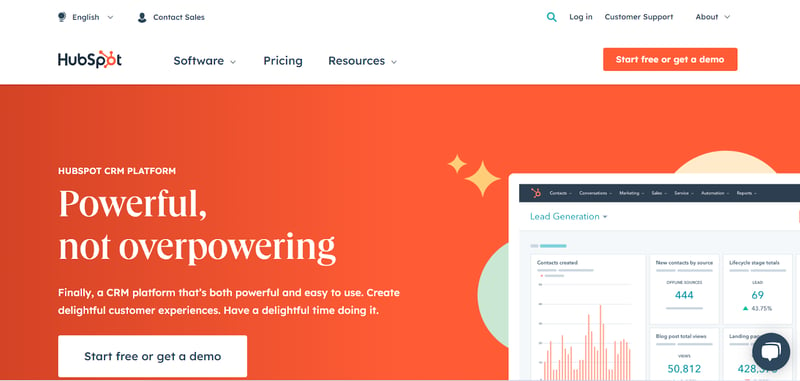
The Art of Needs Based Selling: Understanding Your Customers to Drive Sales Success
 Updated on
Updated on
 By Carlos Correa
By Carlos Correa
Carlos Correa
Carlos has been involved in the sales space for well over ten years. He began in the insurance space as an individual sales agent, managing teams as s...
learn more
Carlos Correa
Carlos has been involved in the sales space for well over ten years. He began in the insurance space as an individual sales agent, managing teams as s...
Table of Contents
Table of Contents
Selling can be a lot like dating - you need to understand the other person's wants and needs before you make your move. Just like bringing a bouquet of flowers on a first date won't impress someone who's allergic, pitching a product or service that doesn't meet your customer's needs won't lead to sales success.
That's where needs-based selling comes in. By taking the time to understand your customer's pain points and desires, you can tailor your approach to meet their specific needs and drive sales. In this article, we'll explore the basic stages of needs-based selling, provide examples, and give tips for incorporating it into your sales training.
So grab a cup of coffee and get ready to learn how to win your customers' hearts (and wallets) through the art of needs-based selling.
What Is Needs Based Selling?
Needs-based selling, also known as consultative or customer-centric selling, is a sales approach in which the salesperson focuses on understanding the customer's specific needs, challenges, and desires.
Instead of promoting a product or service solely based on its features, the salesperson tailors the pitch to address the customer's unique requirements and explain how the offering can provide the best solution.
It is the opposite of transactional selling, in which the salesperson simply connects the customer to a solution without first understanding their needs. Needs-based selling is a more effective approach because it allows the salesperson to tailor the pitch to the specific needs of the customer.
Let's say a customer enters a store looking for a new laptop. Rather than immediately trying to sell the customer the most expensive laptop in the store, a needs-based salesperson would ask the customer about their needs and preferences.
By taking the time to understand the customer's needs, the salesperson is more likely to make a sale and leave the customer with a positive experience.
How to Do Needs-Based Selling Successfully

Now that you understand what needs-based selling is, let's look at how to do it successfully. Here are four tips for incorporating this approach into your sales process:
1. Build Rapport
Building rapport is essential to needs-based selling as it helps establish trust and credibility with the customer, leading to a deeper understanding of their needs. Here are some tips on how to build rapport successfully in needs-based selling:
|
Tips |
Description |
|
Be Genuine |
Customers can quickly sense when someone is insincere or not genuine. Therefore, it is crucial to be authentic in your interactions with them. You can start by introducing yourself and expressing your desire to understand their needs better. |
|
Listen Actively |
Listening actively means paying full attention to the customer and focusing on what they say. According to research, active listening increases customer satisfaction and builds trust. |
|
Empathize |
Demonstrating empathy shows that you care about the customer's situation and are interested in helping them find a solution. |
|
Use Positive Body Language |
Positive body language signals that you are approachable, friendly, and open to hearing the customer's concerns. |
|
Find Common Ground |
Look for common interests or experiences you share with the customer. Finding common ground can create a connection and foster a positive relationship. |
2. Identify Your Customer’s Needs
A customer's needs can be categorized into four key areas:
|
Needs Category |
Needs-Based Selling Techniques |
|
Functional Needs |
Ask open-ended questions about their current processes and challenges. For example, "Can you walk me through a typical workday and the challenges you encounter?" Use active listening to understand their specific pain points, |
|
Emotional Needs |
Listen for emotional cues in their language. What frustrations do they express? What goals do they seem passionate about? Ask questions that uncover their desired outcomes. For example, "What would an ideal solution look like for you?" |
|
Budgetary needs |
Directly ask about their budget in a non-confrontational way. For example, "Do you have a specific budget in mind for this project?" Present pricing options that align with their financial constraints. |
|
Time-related Needs |
Ask questions about their desired implementation timeline. For example, "When would you ideally like to see this solution implemented?" Present options with varying implementation timelines to accommodate their needs. |
3. Ask the Right Questions
Asking the right questions is crucial in the needs-based selling process because it helps you understand the customer's needs and create a customized solution for them. Here's how to ask the right questions in needs-based selling.
- Start with open-ended questions. Open-ended questions allow customers to provide detailed answers and reveal their needs, desires, and pain points.
- Focus on the customer's goals. By asking questions about the customer's goals, you can tailor your sales pitch to align with their objectives.
- Identify the customer's pain points. Understanding the customer's pain points helps you empathize with their situation and offer solutions to their challenges.
- Confirm your understanding. It's important to summarize the customer's responses and confirm your understanding to avoid misunderstandings and ensure you address their needs.
Here are some examples of questions you can ask your customer:
- What are your business objectives?
- What challenges are you currently facing?
- What is the outcome that you're looking for?
- What criteria will you use to determine the best solution?
- What budget and timelines do you have in mind?
- What are your expectations for the product/service?
According to research, truly listening to customers is a game-changer, boosting retention rates by a significant 30%.
4. Confirm the Issue
Before you offer a solution, you'll need to confirm the customer's issue and address their concerns. Confirming the issue helps build trust, showing that you understand the customer's situation and can help them.
It also helps narrow down what your product or service can do to meet their needs. Ask relevant questions to understand the customer's problem better and confirm the issue.
Use active listening techniques to get an accurate idea of what they need. Don't be afraid to show empathy. Your goal is to help solve their problem! Once the issue has been confirmed, you can move on to the next step.
5. Offer a Solution
Now that you understand the customer's needs, it's time to offer a solution. You can do this by presenting how your product or service can benefit them. Be sure to highlight the features and benefits in alignment with their desired outcome and any competitive advantages your product has over others.
When discussing pricing, be transparent and upfront. This will make the customer feel more comfortable and confident in your offer. It's also important to check that they understand what you're offering, as this will help ensure clarity and communication.
Finally, allow the customer space to process your solution before closing the deal. This gives them time to think it over and ask any questions they might have.
Basic Stages of Needs Based Selling

At this point, you've identified the customer's needs and can begin to shape the conversation around them. But how do you move from understanding their needs to making a sale? That's where the basic stages of needs based selling come in.
1. Research and Preparation
The research and preparation stage involves understanding the customer's industry, business goals, pain points, and other relevant information. Sales reps can use CRM software to track customer data and insights, such as previous interactions, preferences, and behavior patterns, to personalize the sales pitch.
2. Discovery
To better understand the customer's pain points and business objectives, the sales representative should ask questions and attentively listen to their answers during the next phase.
Let's say an IT manager is looking for a cloud-hosting solution for their business. The software's sales rep should ask questions about the customer's current system and the features they want in a new one.
3. Presentation
Based on the discovery stage, the sales rep presents the product as a solution to the customer's pain points and business goals. The presentation should focus on the benefits and value the product offers the customer rather than just its features.
Example: The sales rep presents the software solution to streamline production scheduling, reduce errors, and improve efficiency. The presentation should also include examples of similar firms successfully using their cloud-hosting software.
4. Objection Handling
During this stage, the sales rep addresses any objections or concerns the customer may have about the product. This involves understanding the customer's perspective and offering alternative solutions or clarifications to alleviate concerns.
Suppose the IT manager expresses concern about the cost of the software. The sales rep can offer a breakdown of the ROI and a comparison to the cost of the firm's current system.
5. Closing the Sale
To complete the sale, summarize the customer's requirements and explain how your product meets them. This serves as a reminder and reinforces their decision to buy. Walk the customer through a payment plan and associated fees or discounts. Doing so will help finalize the sale and make it easier for the customer to commit.
Using a CRM can benefit the needs-based selling approach in several ways.
- Firstly, it can provide valuable insights into the customer's behavior and preferences, allowing sales reps to tailor their approach accordingly.
- Secondly, it can help sales reps manage their pipeline, track their progress, and prioritize their activities.
- Lastly, it can enable effective communication and collaboration between sales reps and other stakeholders, such as marketing and customer service teams.
Benefits of Needs-Based Selling
By prioritizing understanding your customer's needs, needs-based selling offers a multitude of advantages for both you and your customer. Let's explore some of the key benefits:
Building Trust and Credibility With Customers
In a world of generic sales pitches, needs-based selling sets you apart. By actively listening and focusing on uncovering a customer's specific challenges, you demonstrate genuine interest in their success. This customer-centric approach builds trust and establishes you as a credible advisor, not just a salesperson.
Tailoring Solutions to Meet Specific Customer Requirements
When you understand a customer's unique needs, you can move away from generic product presentations. Instead, you can tailor your approach to showcase how your product or service directly addresses their functional needs, emotional needs, budgetary needs, and time-related needs. This targeted approach resonates more deeply with the customer, as they see the clear value proposition for their specific situation.
Increasing Customer Satisfaction and Loyalty
Focusing on solutions that truly address a customer's needs increases the likelihood of delivering a product or service that exceeds their expectations. This leads to higher customer satisfaction and fosters long-term loyalty. Satisfied customers are more likely to become repeat buyers and recommend your business to others through positive word-of-mouth promotion.
Enhancing Sales Performance and Closing Rates
Understanding a customer's needs allows you to craft compelling sales presentations that directly address their pain points and desired outcomes. This targeted approach is far more effective than generic pitches, leading to increased sales performance and higher closing rates.
Differentiating From Competitors by Providing Value-Added Solutions
In a crowded marketplace, it's crucial to stand out from the competition. Needs-based selling allows you to do just that. When you focus on the unique value proposition your product or service offers to each customer, you move beyond simply selling features. You are seen as a trusted advisor who can deliver a customized solution that creates lasting value for your business.
Needs Based Selling Examples
Needs-based selling can be used in a variety of industries. Let's take a look at some real-life examples of businesses using needs-based selling to drive sales success:
1. Apple Inc.

When customers visit an Apple store or its website, they are asked questions about what they need in a device, their preferred features, and how to use it. Based on the customer's answers, the sales team recommends products that meet their needs, such as the MacBook Air for students who need a lightweight laptop for studying and taking notes or the iPad for professionals who need a portable device for presentations and meetings.
Apple's needs-based selling approach has helped the company maintain a loyal customer base and drive sales.
2. Amazon

Amazon uses needs-based selling in its product recommendations algorithm. The company analyzes customers' browsing and purchase histories to recommend products that meet their needs and interests.
For example, if a customer frequently buys pet food and toys, Amazon may recommend pet grooming products, leashes, and other accessories. Using needs-based selling, Amazon provides a personalized shopping experience and increases the likelihood of repeat purchases.
3. HubSpot

HubSpot offers a range of products and services to help businesses generate leads, manage customer relationships, and automate marketing tasks. When a potential customer contacts HubSpot, the sales team asks questions about their business needs, such as their current marketing strategy, pain points, and goals.
Based on their responses, the sales team recommends products to help customers achieve their goals. HubSpot's needs-based selling approach has helped the company build strong customer relationships and become a leader in the marketing software industry.
In these examples, the companies use a needs-based selling approach to understand their customers' needs, provide personalized recommendations, and ultimately increase sales and customer loyalty.
4. Insurance Industry
In the insurance industry, needs-based selling is crucial for understanding and addressing the unique requirements of individual clients.
For instance, prominent insurance brands like United Health Group (UNH) or Berkshire Hathaway utilize needs-based selling by conducting thorough client consultations to assess their specific life and health insurance needs.
Instead of offering standardized insurance packages, this approach involves personalized discussions to uncover the client's financial situation, family dynamics, plans, and health considerations. By tailoring insurance solutions to match these identified needs, these brands not only enhance the relevance of their offerings but also build trust and credibility with clients.
5. DropBox

Dropbox doesn't just sell storage space; it sells solutions. Its salespeople act as consultants, uncovering a client's specific needs through questions about current storage systems, remote collaboration challenges, and data security concerns.
By understanding these functional needs, they tailor their pitch to showcase how Dropbox features directly address those challenges. For instance, they might highlight secure remote access for collaboration and robust version control for data security. This targeted approach positions Dropbox as a customized solution, not just another storage option.
Conclusion

Needs-based selling is an effective approach that involves understanding the needs and objectives of customers to provide tailored solutions that drive sales success. By asking specific questions about a customer's business goals, challenges, budget, and expectations, you can gain valuable insights into their needs and create a customized solution.
If you want to make the most of needs-based selling and increase customer acquisition, Ringy CRM is here to help. Our comprehensive CRM platform allows you to manage customer relationships, capture leads, track sales activities, and more. Contact us today to learn how we can help your business succeed!

Skyrocket your sales with the CRM that does it all.
Calling? Check. SMS? Check. Automation and AI? Check. Effortlessly keep in touch with your customers and boost your revenue without limits.

Take your sales to new heights with Ringy.
Sales in a slump? Ringy gives you the tools and flexibility you need to capture leads, engage with them, and turn them into customers.
Subscribe to Our Blog
Enter your email to get the latest updates sent straight to your inbox!
Categories
Related Articles



































































































